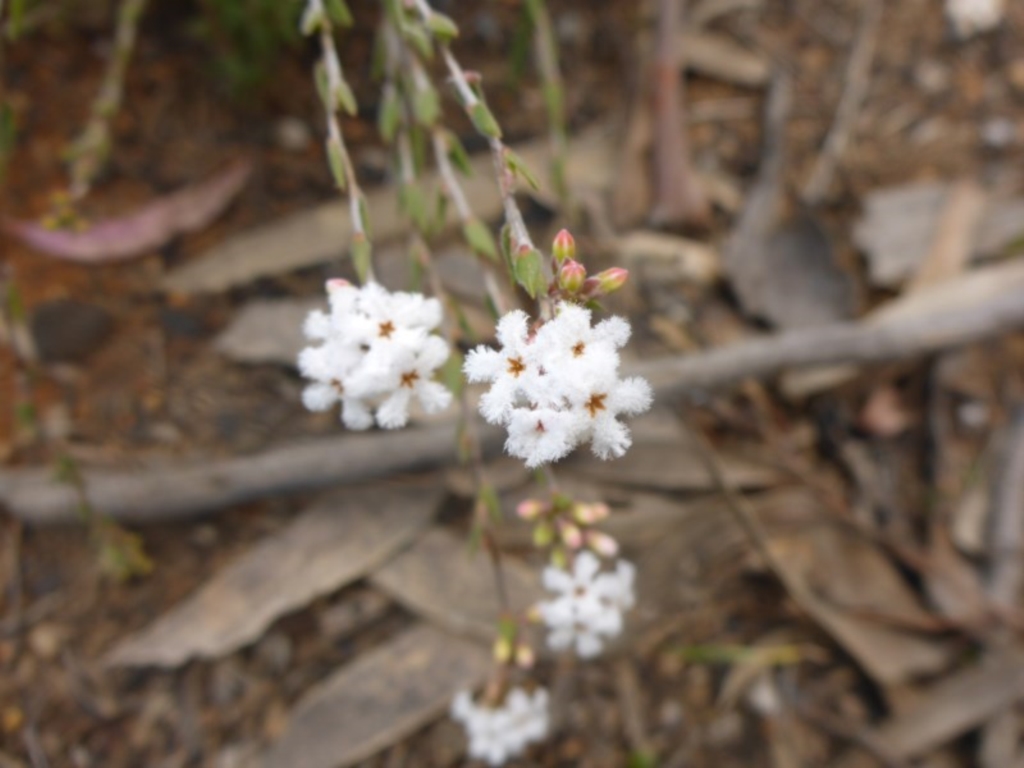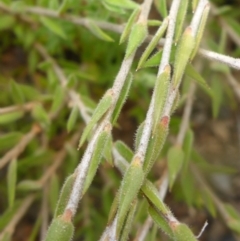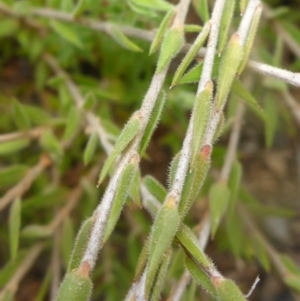Common Beard-heath at Aranda, ACT
Identification history
| Leucopogon virgatus | 18 Apr 2016 | MichaelMulvaney | ||
| Leucopogon microphyllus var. pilibundus | 26 Sep 2015 | JanetRussell |
Identify this sighting
Please Login or Register to identify this sighting.
8 comments
BettyDonWood
wrote:
1 Oct 2015
Flora of ACT says that Leucopogon microphyllus var. pilibundus has obtuse leaves with a recurved apiculum (tip) and L. virgatus has narrow lance shaped leaves with an erect callous apex. PlantNET say L. microphyllus has convex leaves, and L. virgatus has concave leaves.
JanetRussell
wrote:
3 Oct 2015
I am going cross-eyed looking at this genus. My photo shows hairy leaves and stems and L. virgatus is glabrous. The specimens of L. microphyllus var pilibundus on CNM do not all look as if they have blunt leaves. The leaves on my specimen seem to taper more than L. virgatus. I think I will change the ID to Leucopogon sp. unless you can throw some light on it.
BettyDonWood
wrote:
3 Oct 2015
Unfortunately PlantNET does not mention the characters that Flora of the ACT thinks is important. PlantNET's descriptions are based solely on what is held at the herbarium in Sydney. I am travelling for the next two weeks so caninot check the description in Floa of the ACT while I am away. Take a specimen into the Botanic Gardens. If the plant is on public land you will need a permit to collect.
KenT
wrote:
3 Oct 2015
Janet, I also feel the same level of difficulty you are having with these species in this group of Leucopogon. The more images I make of this genus the more confused I get. There are some examples on this site that appear to show mostly complete resemblance to the PlantNET description and illustration for L. virgatus. Then we also have some other examples that look like the one you have here and also some that I’ve put up that appear closer to L. microphyllus var pilibundus, at least as far as the venation and hairiness of the leaves is concerned. The level of hairiness on bracteoles and sepals may not be consistent with the PlantNET description. I haven’t been able to find any recent taxonomic work on the Australian members of this genus that uses both morphology and molecular characteristics and I don’t know if we get interspecific hybrids between the two species that could also add to the confusion. When different floras focus on different characteristics in their keys and descriptions there is no easy solution to what you give most weight to when making a determination, it’s a judgment call we have to leave to our experts. Nonetheless one hopes that the work of more recent floras builds on and extends that of previous authorities and in this case that the PlantNET people would have considered Nancy Burbidge’s ACT work and the work of others in developing their statewide keys and descriptions. Betty has made the suggestion to take a specimen to the ANBG, if you can get a collecting permit you might consider taking a good 10x hand lens with you and collect a few specimens from a number of plants that exhibit a range of variation in the characteristics related to leaf shape and hairiness. Ken
JanetRussell
wrote:
4 Oct 2015
Thanks Ken, I found that interesting. I will do as Betty suggests and what you have enlarged upon. My trouble will be in finding enough specimens I think. Janet
RWPurdie
wrote:
13 Apr 2016
This looks like Leucopogon virgatus to me. After checking many herbarium specimens and plants in the field from Black Mtn of three similar Leucopogon species, the following are the distinguishing features. Once you get your eye in, they're relatively easy to tell apart from their habit.
Leucopogon virgatus: has a sprawling/decumbent habit with often many slender stems from a woody rootstock; leaves are flattish to concave on the upper surface, hairy, sometimes especially so on the margins, with an acuminate tip that ends in a callous; the inflorescence is a spike of 4-7 flowers at the ends of the branchlets.
Leucopogon microphyllus var. pillibundus: is an erect, often compact subshrub; leaves are usually concave on the upper surface, hairy, often especially so on the margins, with an obtuse tip that has a recurved apiculum; the inflorescence is a spike or cluster of 4-9 flowers at the ends of the branchlets.
Leucopogon attenuatus: is usually an erect shrub; leaves are concave on the upper surface, hairy, with a sharp pointed tip that is not recurved; the inflorescence is a cluster of 1-3 flowers in the axils of the leaves along the branchlets.
Leucopogon virgatus: has a sprawling/decumbent habit with often many slender stems from a woody rootstock; leaves are flattish to concave on the upper surface, hairy, sometimes especially so on the margins, with an acuminate tip that ends in a callous; the inflorescence is a spike of 4-7 flowers at the ends of the branchlets.
Leucopogon microphyllus var. pillibundus: is an erect, often compact subshrub; leaves are usually concave on the upper surface, hairy, often especially so on the margins, with an obtuse tip that has a recurved apiculum; the inflorescence is a spike or cluster of 4-9 flowers at the ends of the branchlets.
Leucopogon attenuatus: is usually an erect shrub; leaves are concave on the upper surface, hairy, with a sharp pointed tip that is not recurved; the inflorescence is a cluster of 1-3 flowers in the axils of the leaves along the branchlets.
KenT
wrote:
17 Apr 2016
Thanks Rosemary for looking over all these Black Mountain Leucopogon records. It seems your understanding of L. virgatus as it occurs in the ACT encompasses a greater range of leaf characteristics than PLantNET’s somewhat sparse description (e.g. margins entire or sparsely toothed; lamina glabrous, concolorous, upper surface concave, lower surface with 3 central ± parallel veins) and accompanying illustrations. Based on your notes it seems all three of these species can have concave hairy leaves and the best way to distinguish them is on their growth habit and the nature of the pointy tip at the end of the leaves. I assume assessing the growth habit requires a bit of caution as: (1) herbivore grazing seems to change the shape a bit as I’m fairly sure I’ve seen semi-compact Leucopogons that would otherwise fit the PlantNET description for L. virgatus; and (2) young plants while still capable of flowering may take some years to express their ultimate growth form. I will have to pay a bit more attention to these characteristics when I’m next out looking at members of this genus. On another related matter, on one of my records you marked as inconclusive I have added a crop from the second image which should help with the species determination for: http://canberranaturemap.org/Community/Sightings/Details/1946310
BettyDonWood
wrote:
18 Apr 2016
Just to add to the mess with these three species, the Vicflora descriptions for these three species partly agree with what Rosemary described from the ACT material, and partly with the descriptions of the material in the NSW herbarium in Plantnet. All three species were described before 1830. Knowing hoe scrappy the descriptions were at that time, and given that the type specimens for two of them are probably in France, perhaps a Post doctoral project looking Australia wide to sort it out? In the mean time, I think we should use Rosemary's description for ACT material.
Please Login or Register to comment.
Nearby sightings
Location information
- Coordinates 149.087122-35.257836
- Altitude 516.0m
- Places Aranda, ACT
Sighting information
- 1 - 3 Abundance
- 25 Sep 2015 04:04 PM Recorded on
- JanetRussell Recorded by
Additional information
- True In flower
Species information
- Leucopogon virgatus Scientific name
- Common Beard-heath Common name
- Not Sensitive
- Local native
- Non-Invasive
- Up to 1033.41m Recorded at altitude
- Machine learning
-
In flower
Record quality
- Images or audio
- More than one media file
- Confirmed by an expert moderator
- Nearby sighting(s) of same species
- GPS evidence of location
- Description
- Additional attributes





















